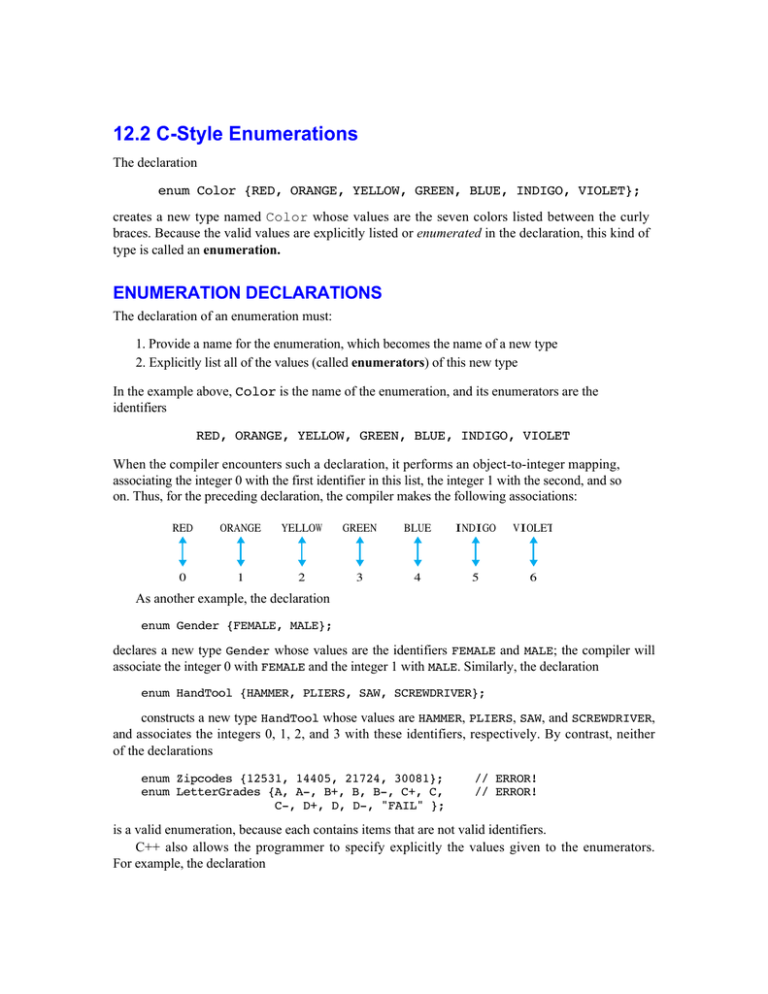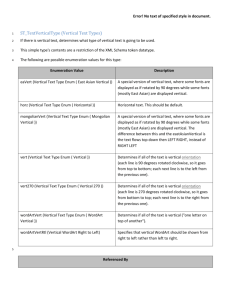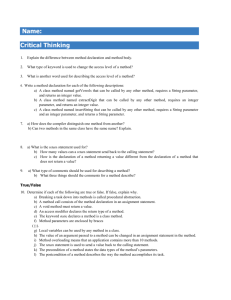12.2 C-Style Enumerations
advertisement

12.2 C-Style Enumerations
The declaration
enum Color {RED, ORANGE, YELLOW, GREEN, BLUE, INDIGO, VIOLET};
creates a new type named Color whose values are the seven colors listed between the curly
braces. Because the valid values are explicitly listed or enumerated in the declaration, this kind of
type is called an enumeration.
ENUMERATION DECLARATIONS
The declaration of an enumeration must:
1. Provide a name for the enumeration, which becomes the name of a new type
2. Explicitly list all of the values (called enumerators) of this new type
In the example above, Color is the name of the enumeration, and its enumerators are the
identifiers
12.2 C-Style Enumerations
RED, ORANGE, YELLOW, GREEN, BLUE, INDIGO, VIOLET
745
When the compiler encounters such a declaration, it performs an object-to-integer mapping,
associating the integer 0 with the first identifier in this list, the integer 1 with the second, and so
on. Thus, for the preceding declaration, the compiler makes the following associations:
RED
ORANGE
YELLOW
GREEN
BLUE
INDIGO
VIOLET
0
1
2
3
4
5
6
As another example, the declaration
As another example, the declaration
enum Gender {FEMALE, MALE};
enum Gender
{FEMALE,
MALE};
declares
a new type
Gender whose values are the identifiers FEMALE and MALE; the compiler will
associate
thetype
integer
0 withwhose
FEMALE and the integer 1 with MALE. Similarly, the declaration
declares
a new
Gender
values are the identifiers FEMALE and MALE; the compiler will
associateenum
the integer
0 with{HAMMER,
FEMALE and
the integer
MALE. Similarly, the declaration
HandTool
PLIERS,
SAW,1 with
SCREWDRIVER};
a new
type HandTool
whose
are HAMMER, PLIERS, SAW, and SCREWDRIVER,
enumconstructs
HandTool
{HAMMER,
PLIERS,
SAW,values
SCREWDRIVER};
and associates the integers 0, 1, 2, and 3 with these identifiers, respectively. By contrast, neither
constructs
a new type HandTool whose values are HAMMER, PLIERS, SAW, and SCREWDRIVER, and
of the declarations
associates the integers 0, 1, 2, and 3 with these identifiers, respectively. By contrast, neither of
enum Zipcodes {12531, 14405, 21724, 30081};
// ERROR!
the declarations
enum LetterGrades {A, A-, B+, B, B-, C+, C,
// ERROR!
C-, D+, D, D-, "FAIL" };
enum Zipcodes {12531, 14405, 21724, 30081}; // ERROR!
isenum
a valid
enumeration, because
each
contains
items
thatC,are //
not ERROR!
valid identifiers.
LetterGrades
{A, A-,
B+,
B, B-,
C+,
C++ also allows the C-,
programmer
to
specify
explicitly
the
values given to the enumerators.
D+, D, D-, "FAIL" };
For example, the declaration
is a valid enumeration, because each contains items that are not valid identifiers.
C++ also allows the programmer to specify explicitly the values given to the enumerators.
For example, the declaration
enum NumberBase {BINARY = 2,
OCTAL = 8,
DECIMAL = 10,
enum NumberBase {BINARY = 2,
OCTAL = 8,
DECIMAL = 10,
HEX = 16, HEXADECIMAL = 16};
associates the identifiers BINARY, OCTAL, DECIMAL, HEX, and HEXADECIMAL with the values 2, 8,
10, 16, and 16, respectively. Because each enumerator is a power of 2, each has a 1 at a different
position in its binary representation. Such enumerators are called bit masks, and make it possible
to efficiently store a boolean value such as an iostream status attribute using only a single bit of
memory.
Similarly, if we wished to have the values 1, 2, . . . , 7 associated with the seven colors given
earlier (instead of 0 through 6), we could use the declaration
enum Color {RED = 1, ORANGE = 2, YELLOW = 3, GREEN = 4,
BLUE = 5, INDIGO = 6, VIOLET = 7};
or more compactly,
enum Color {RED = 1, ORANGE, YELLOW, GREEN, BLUE, INDIGO, VIOLET};
because the integer associated with an enumerator is, by default, one more than the integer
associated with the preceding enumerator. The iostream library uses an enumeration
declaration something like
enum Flag {GOOD_BIT = 1, BAD_BIT, FAIL_BIT = 4, EOF_BIT = 8};
which associates 1 with GOOD_BIT, 2 with BAD_BIT, 4 with FAIL_BIT, and 8 with EOF_BIT.1
These examples illustrate the flexibility of C++—the integers associated with the names need
not be distinct nor must they be given in ascending order, although it is good programming style
to do so.
The general form of an enumeration declaration is as follows:
Enumeration Declaration Statement
Form:
enum TypeName { List };
where:
TypeName is an identifier naming a new type; and
List is a list of the values for the new type, separated by commas, each of which is a valid
IDENTIFIER
or an initialization expression of the form
IDENTIFIER = integer_constant
Purpose:
Define a new data type whose values are the identifiers in List. Each identifier is
associated with an integer as follows:
If an item in List has the form IDENTIFIER = integer_constant, then
integer_constant is associated with IDENTIFIER;
otherwise if it is the first item in the list,
0 is associated with the IDENTIFIER;
otherwise,
1 + (the integer associated with the preceding identifier) is associated with the
IDENTIFIER.
Because the compiler essentially treats an enumeration as a series of constant integer declarations,
we use the same uppercase naming convention for enumerators that we use for constant objects.
DEFINING ENUMERATION OBJECTS
To illustrate how enumerations are used, consider the following expansion of enumeration
Color:
enum Color {COLOR_UNDERFLOW = -1,
RED, ORANGE, YELLOW, GREEN,
BLUE, INDIGO, VIOLET,
COLOR_OVERFLOW,
NUMBER_OF_COLORS = 7};
// too-low indicator
// 0-3
// 4-6
// too-high indicator
Here, we added the identifiers COLOR_UNDERFLOW and COLOR_OVERFLOW as values to indicate
out-of-range errors. These values can be used to keep from “falling off the ends of the list.” We also
added the identifier NUMBER_OF_COLORS, whose value is the number of values in the list, because
this count is often useful.
If it is worthwhile to define a new type, it is usually worth taking the time to store that type in
a library so that it can be easily reused. We thus store this declaration of type Color in a header
file Color.h so that programs can include it and avoid reinventing the wheel.
Given this type, we can declare a Color object named theColor:
Color theColor;
Enumeration objects can also be initialized when they are declared:
Color theColor = YELLOW;
USING ENUMERATIONS
In addition to defining enumeration objects, an enumeration can be used as the index of an array.
For example, suppose we define colorArray as follows:
double colorArray[NUMBER_OF_COLORS] = {0.0};
This definition builds the object colorArray as a fixed-size array with index values 0 through 6.
Because the C++ compiler treats the identifiers RED through VIOLET as the integer values 0
through 6, we can visualize colorArray as follows:
This definition builds the object colorArray as a fixed-size array with index values 0 through 6.
Because the C++ compiler treats the identifiers RED through VIOLET as the integer values 0
through 6, we can visualize colorArray as follows:
colorAr ray
0.0
[RED]
0.0
0.0
0.0
[ORANGE] [YELLOW] [GREEN]
0.0
0.0
0.0
[BLUE] [ INDIGO] [VIOLET]
The Color enumerators can then be used with the subscript operator to access the array eleThe Color enumerators can then be used with the subscript operator to access the array
ments.
elements.
In the same way, an extra enumerator like NUMBER_OF_COLORS can be used to provide a vecIn the same way, an extra enumerator like NUMBER_OF_COLORS can be used to provide a
tor<T>
with anwith
initial
size: size:
vector<T>
an initial
748
Chapter 12 • Classes and Enumerations
vector<double>
colorVector(NUMBER_OF_COLORS);
vector<double>
colorVector(NUMBER_OF_COLORS);
Thisdefines
definescolorVector
colorVector
a varying-sizedobject,
object, initially
This
asas
a varying-sized
initiallywith
withNUMBER_OF_COLORS
seven elements: elements:
colorVector
0.0
[RED]
0.0
0.0
0.0
[ORANGE] [YELLOW] [GREEN]
0.0
0.0
0.0
[BLUE] [ INDIGO] [VIOLET]
C-STYLE ENUMERATION OPERATIONS
Many enumeration operations are predefined. For example, an enumeration object can be
assigned a value, used as a parameter, compared using the relational operators, and so on. But
other operations must be defined by the creator or user of the enumeration. For example, the program in Figure 12-1 requires computing the wavelength corresponding to a Color value. Since
there is no predefined operation to do this, one must be provided. The function in Figure 12-2
shows one way to do this. Because this Color operation is nontrivial, its definition should be
stored in the library’s implementation file Color.cpp and its prototype in the header file Color.h.
Figure 12-2 Computing Color Wavelength.
// ------- Wavelength of a Color ---------------------------------double wavelength(Color aColor)
{
switch(aColor)
{
case RED:
return 6.5E-7;
case ORANGE:
return 6.0E-7;
case YELLOW:
return 5.8E-7;
case GREEN:
return 5.2E-7;
case BLUE:
return 4.7E-7;
case INDIGO:
return 4.4E-7;
case VIOLET:
return 4.1E-7;
default:
cerr << "\n*** wavelength: invalid color "
"received!\n";
return 0.0;
}


